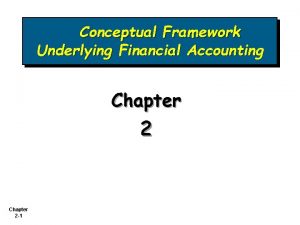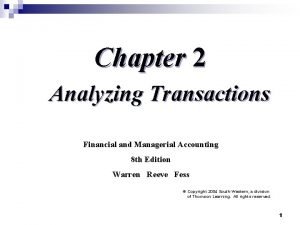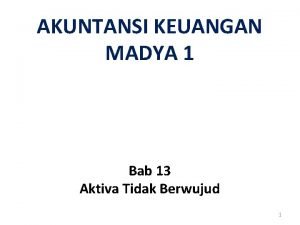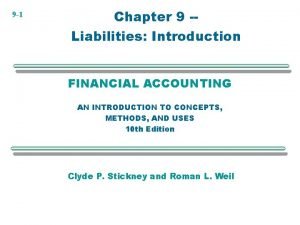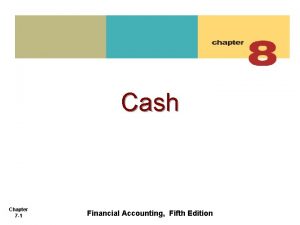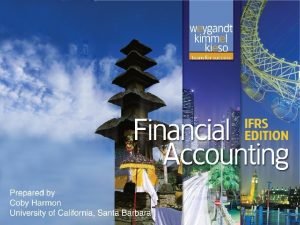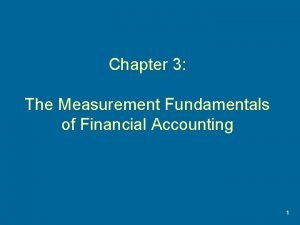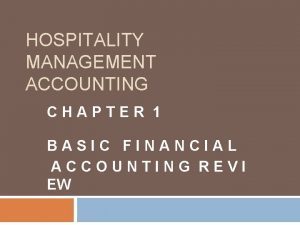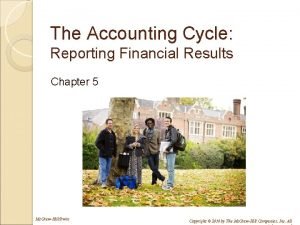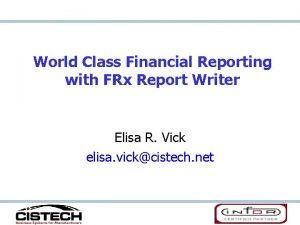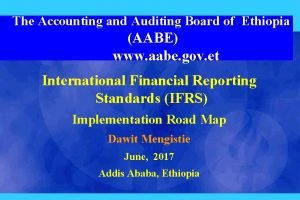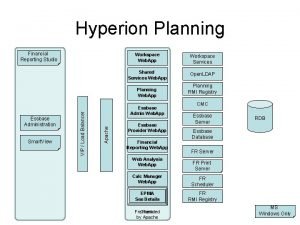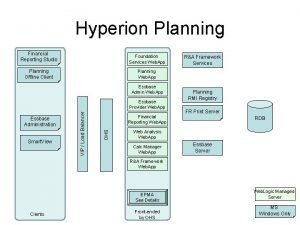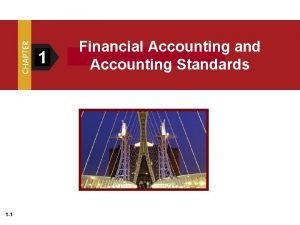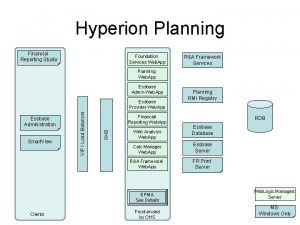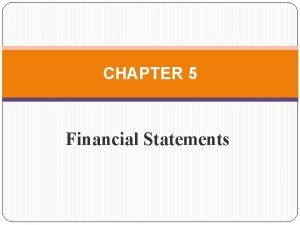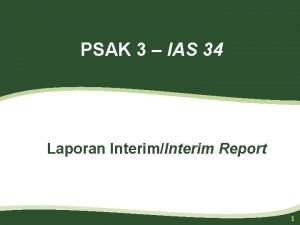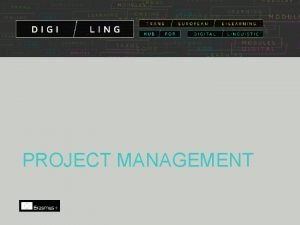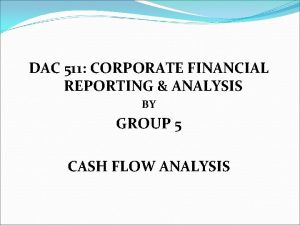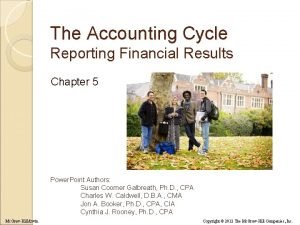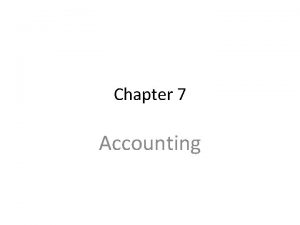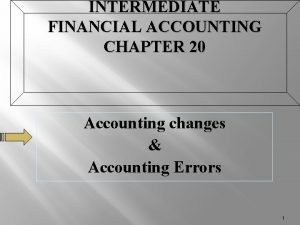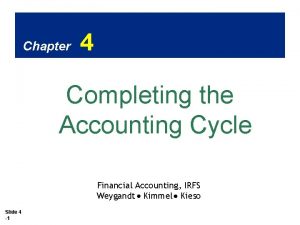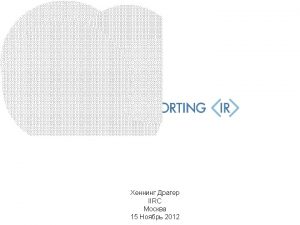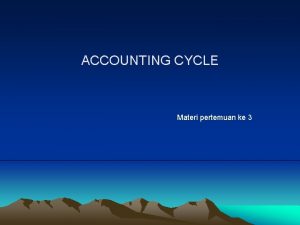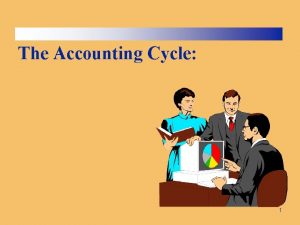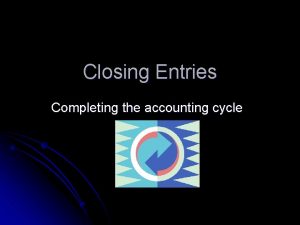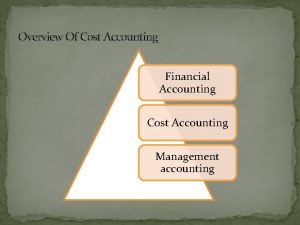The Accounting Cycle Reporting Financial Results Chapter 5




























- Slides: 28

The Accounting Cycle Reporting Financial Results Chapter 5 Power. Point Authors: Susan Coomer Galbreath, Ph. D. , CPA Charles W. Caldwell, D. B. A. , CMA Jon A. Booker, Ph. D. , CPA, CIA Cynthia J. Rooney, Ph. D. , CPA Mc. Graw-Hill/Irwin Copyright © 2012 The Mc. Graw-Hill Companies, Inc. 5 -1

THE ACCOUNTING CYCLE Process by which accountants prepare financial statements for an entity for a specific period of time 5 -2

Accounting Cycle Journalize Transaction Post to Accounts Adjust Accounts Close Accounts Prepare Financial Statements 5 -3

Review – Accounting Cycle 1. 2. 3. 4. 5. 6. 7. 8. Analyze transactions. Prepare general journal entries, and post to general ledger. Prepare unadjusted trial balance. Prepare adjusting journal entries, and post to general ledger. Prepare adjusted trial balance. Prepare financial statements. Prepare closing journal entries, and post to general ledger. Prepare post-closing trial balance. 5 -4

A) Preparing Financial Statements Publicly owned companies – those with shares listed on a stock exchange – have obligations to release annual and quarterly information to their stockholders and to the public. The annual report includes comparative financial statements and other information relating to the company’s financial position, business operations, and future prospects. The financial statements contained in the annual report must be audited by a firm of certified public accountants (CPAs). 5 -5

Now, let’s prepare the financial statements for JJ’s Lawn Care Service for May. 5 -6

1) The Income Statement Net income also appears on the Statement of Retained Earnings. 5 -7

2) The Statement of Retained Earnings Summarizes the increases and decreases in Retained Earnings during the period. Business Earnings Dividends Business Losses 5 -8

The Statement of Retained Earnings Now, let’s prepare the Balance Sheet. 5 -9

3) The Balance Sheet 5 -10

Relationships Among the Financial Statements 5 -11

Drafting the Notes that Accompany Financial Statements Examples of Items Disclosed Notes to the Financial Statements ŸLawsuits pending ŸScheduled plant closings ŸGovernmental investigations ŸSignificant events occurring after the balance sheet date ŸSpecific customers that account for a large portion of revenue ŸUnusual transactions and related party transactions 5 -12

B) Closing the Temporary Accounts The closing process gets the temporary accounts ready for the 2. Close Expense accounts next accounting period. to Income Summary. 1. Close Revenue accounts to Income Summary. 3. Close Income Summary account to Retained Earnings. 4. Close Dividends to Retained Earnings. 5 -13

Closing the Temporary Accounts 5 -14

Closing Entries for Revenue Accounts Since Sales Revenue has a credit balance, the closing entry requires a debit to the Sales Revenue account. 5 -15

Closing Entries for Revenue Accounts 5 -16

Closing Entries for Expense Accounts Since expense accounts have a debit balance, the closing entry requires a credit to the expense accounts. 5 -17

Closing Entries for Expense Accounts Net Income 5 -18

Closing the Income Summary Account Since Income Summary has a $400 credit balance, the closing entry requires a debit to Income Summary. 5 -19

Closing the Income Summary Account The balance in Income Summary is now zero. 5 -20

Closing the Dividends Account Since the Dividends account has a debit balance, the closing entry requires a credit to the Dividends account. 5 -21

Closing the Dividends Account 5 -22

C) AFTER-CLOSING TRIAL BALANCE The final Trial Balance after closing will display only permanent, balance sheet accounts. The Retained Earnings in this Trial Balance is the ENDING retained earnings for the period and includes the effects of all the revenues, expenses, and dividends for the period. 5 -23

After-Closing Trial Balance List of permanent accounts and their balances after posting closing entries Total debits and credits must be equal 5 -24

After-Closing Trial Balance 5 -25

EVALUATING THE BUSINESS Evaluating Profitability Net Income = Percentage Total Revenue Return on Equity = Net Income Avg. Stockholders’ Equity Evaluating Liquidity Working Current Assets – = Capital Current Liabilities Current Assets = Ratio Current Liabilities 5 -26

Preparing Financial Statements Covering Different Periods of Time Many companies prepare financial statements at various points throughout the year. Annually Interim Financial Statements Quarterly Monthly Jan. 1 Dec. 31 5 -27

End of Chapter 5 5 -28
 Financial accounting and accounting standards chapter 1
Financial accounting and accounting standards chapter 1 Social responsibility accounting ppt
Social responsibility accounting ppt Us gaap conceptual framework
Us gaap conceptual framework Intermediate accounting chapter 2
Intermediate accounting chapter 2 Third level of conceptual framework
Third level of conceptual framework Beat reporting
Beat reporting Financial accounting chapter 2 solutions
Financial accounting chapter 2 solutions Financial accounting chapter 13
Financial accounting chapter 13 Equity accounted investments
Equity accounted investments Financial accounting chapter 9
Financial accounting chapter 9 Financial accounting chapter 7
Financial accounting chapter 7 Financial accounting ifrs 4th edition chapter 12
Financial accounting ifrs 4th edition chapter 12 Financial accounting chapter 3
Financial accounting chapter 3 Chapter 2 financial accounting answers
Chapter 2 financial accounting answers Management accounting for hotels and restaurants
Management accounting for hotels and restaurants Financial accounting chapter 5
Financial accounting chapter 5 Frx report wizard
Frx report wizard Audit board of ethiopia
Audit board of ethiopia Financial report purpose
Financial report purpose Financial reporting studio
Financial reporting studio Financial reporting studio
Financial reporting studio American accounting standards
American accounting standards What is financial reporting studio?
What is financial reporting studio? What are the 5 types of financial statements?
What are the 5 types of financial statements? Cbd financial reporting framework
Cbd financial reporting framework Ias 34 interim financial reporting
Ias 34 interim financial reporting Project management financial reporting
Project management financial reporting Limitations of annual reports
Limitations of annual reports Direct vs indirect cash flow
Direct vs indirect cash flow




